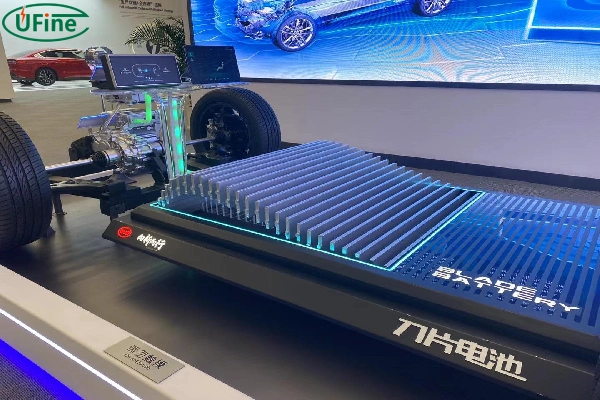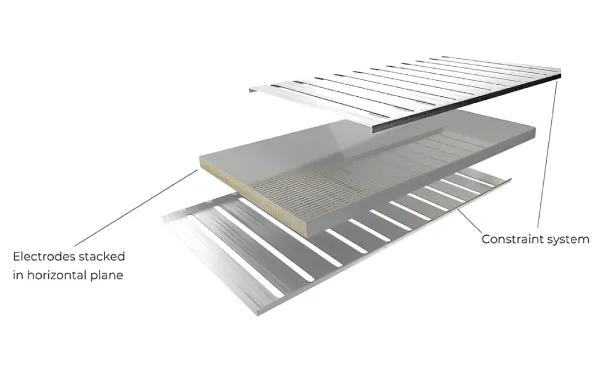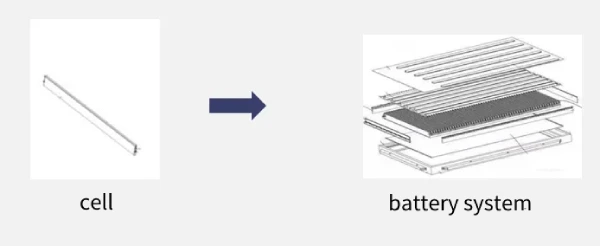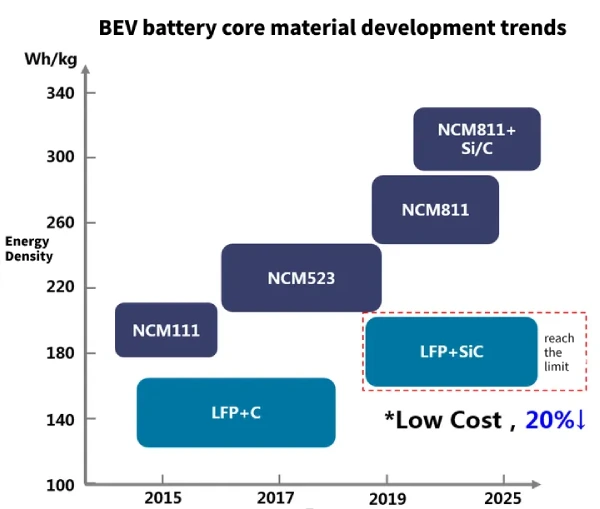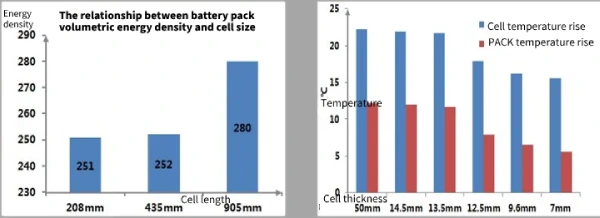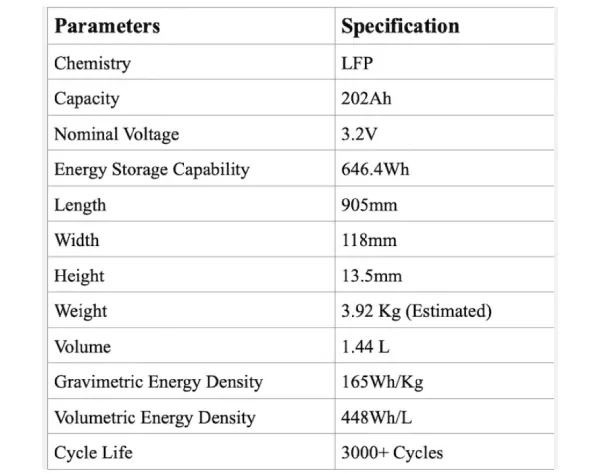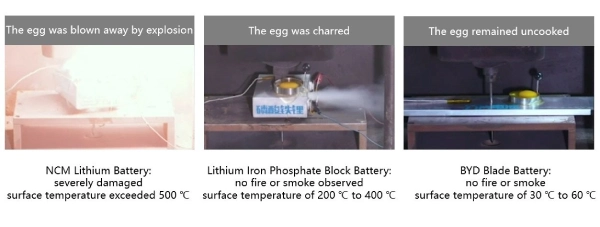Since BYD announced the blade battery for the first time at the 100-person meeting for electric vehicles in January 2020 and the blade battery launch conference on March 29, there has been more discussion about blade batteries in the industry.
There are two main opinions here:
One is that the blade battery has no new ideas, is similar to the CTP of the CATL, and is just a marketing gimmick by BYD.
The other is that blade batteries solve many of the shortcomings of lithium iron phosphate and are groundbreaking.
Next, we will talk about the BYD blade battery.
Part 1. What is a blade battery?
Traditional battery systems first assemble battery cells into battery modules. Then install the battery module into the battery system for hierarchical management.
The battery module supports, fixes, and protects the battery cells in the mechanical structure.
The battery system plays a role in supporting, fixing, and protecting the battery module.
The blade battery is a brand new design concept. While using long batteries, the intermediate module link is omitted and the batteries are directly installed into the battery system. This effectively reduces weight and cost. This is similar to CTP in the CATL era.
At the same time, BYD’s battery structure design draws on the principle of honeycomb aluminum panels. The battery core is fixed between two layers of aluminum plates with structural adhesive, allowing the battery core itself to act as a structural member to increase the strength of the entire system.
Prismatic Cell vs. Blade Cell
Let’s take a look at blade batteries again and compare prismatic batteries and blade batteries that are widely used on the market.
- The prismatic cell length is 148 mm, the thickness is 79 mm, and the height is 97 mm. The internal structure is rolled and looks like a brick.
- The blade cell length is 960mm, thickness is 13.5 mm, height is 90 mm, and the internal structure is laminated. Blade batteries are named because their long, thin shape resembles a blade.
Part 2. Blade battery history
Let’s take a look at the development trends of battery materials for pure electric vehicles in recent years. In the field of electric vehicles, there have always been two technical routes, ternary and lithium iron phosphate batteries.
Ternary batteries are chosen by most car companies due to their high energy density. But it has the disadvantage of high cost.
On the contrary, lithium iron phosphate has a lower cost but low energy density. Moreover, the current energy density of lithium iron phosphate is close to the theoretical limit.
BYD is a manufacturer of lithium iron phosphate batteries. Although BYD has used ternary batteries in most of its pure electric vehicles at this stage, it has never given up on the technical route of lithium iron phosphate. Since energy density cannot be exceeded in terms of materials, BYD engineers work from the perspective of system integration.
We summarize the development rules of battery system integration.
First, let’s take a look at the first-generation battery pack, which is a special-shaped battery pack. To save costs, standard modules are used. But the group efficiency is relatively low.
The second generation battery pack is also a special-shaped battery pack. In order to improve the group efficiency, non-standard modules matching the battery structure were selected, which significantly improved the group efficiency.
The above two battery packs are based on traditional passenger car platforms.
The third generation battery pack is mostly used in pure electric vehicle platforms. There are three different development trends, but they have one thing in common, they are all tablet batteries. However, module-less technology, blade battery technology and 590 standard large module technology are applied respectively. In this way, the group efficiency is significantly improved again.
Among them, the blade battery has the highest improvement. Blade batteries cannot achieve higher energy density in battery materials, but they have made breakthroughs in battery system integration. This solves the shortcomings of short battery life of lithium iron phosphate batteries.
This is the background for the birth of blade batteries.
Part 3. BYD blade battery specifications
Part 4. Advantages of blade cells
1. Increased energy density
The disadvantage of low energy density of LFP is inevitable.
By increasing the length of the battery cells and reducing the redundant design of the battery structure and the number of battery cells, BYD engineers can effectively increase the volumetric energy density of the battery cells and the volumetric energy density of the battery pack, thereby improving the vehicle’s cruising range.
From the data published in BYD’s patent, we can see the relationship between different cell lengths and battery pack energy density. It can be clearly found that when the battery cell length increases from 208 to 435mm, the energy density does not change. But when the length increases to 945mm, the energy density increases by 10%.
2. Good heat dissipation
Another advantage of blade batteries is that they have good heat dissipation performance.
We all know that batteries are particularly sensitive to temperature, which is also the main reason that limits battery fast charging time. Therefore, heat dissipation is a very important indicator for battery cells.
Because the blade battery has a larger heat dissipation surface and a thin thickness, the blade battery core has better heat dissipation performance. From the data released by BYD’s blade battery patent, we can see the temperature simulation results of battery cells with different thicknesses inside the blade battery. We can clearly find that as the thickness of the battery core continues to decrease, the temperature rise of the battery core and battery pack during fast charging is getting smaller and smaller, and the heat dissipation performance is getting better and better.
The above two advantages give us an inspiration. BYD develops battery packs and cells in parallel.
During the development process, multiple design simulations were conducted to continuously optimize the battery cell design so that the battery core can match the battery to the greatest extent. This can maximize the performance of the battery core. This is also the biggest advantage of BYD’s vertical integration.
Part 5. Advantages of blade battery
1. Increased battery energy density
We mentioned this before.
The blade battery cancels the module design and reduces the design of many structural parts.
At the same time, the upper and lower boxes are closely connected to the battery core, which significantly improves the volumetric energy density. This is also BYD’s widely publicized 50% increase in volumetric energy density.
2. Low cost
The blade battery cancels the module design and optimizes the battery structure design. The number of secondary battery components has been reduced by 40%, and the low-cost LFP system has been applied, effectively reducing costs.
3. Strong structure
The blade battery PACK is designed on the upper and lower sides of the battery cell, and two high-strength strength plates are bonded using structural adhesive. This creates a structure similar to a honeycomb aluminum plate, allowing each cell to act as a structural beam. Traditional battery packs generally only have 4-5 beams, while blade batteries allow each cell to act as a structural member, so its strength can be imagined. When there is a collision at the bottom of the battery, the battery core can directly withstand a certain range of force.
4. Excellent thermal management
The liquid cooling plate of the blade battery is arranged above the battery core. At the same time, a thermal conductive layer is designed between the battery cores. The heat exchange area of this solution is much larger than that of traditional prismatic battery cells. It can effectively transfer the heat of the battery core to the water-cooling plate.
In addition, the blade battery has good heat dissipation performance, so the heat pipe of the blade battery is excellently designed and can control the maximum temperature difference within the battery within 1 ℃. The current industry standard is 5 ℃
5. Platformization
Blade batteries come in different specifications. Its length can be changed between 435~2500m. In addition, it is a standard flat-type battery pack. Blade Battery can change the size of the battery pack in the X and Y directions according to the vehicle space, and develop batteries of different specifications.
This platform-based battery effectively reduces development costs and time. Its patent shows that there are at least 8 types of blade battery solutions. And corresponding to different sizes of batteries and different arrangements, the double-layer battery solution is also considered. For the integration of the cabinet, there are traditional separation solutions of the chassis and the cabinet, and there are also integrated chassis solutions in which the two are integrated into one.
6. Lower battery pack height
This effectively improves the ergonomics of the entire vehicle. We can look at the two diagrams on the left. Normally, the high-voltage wiring harness and temperature and voltage sensors of a normal battery core are above the battery core, and they all occupy a certain amount of space. The upper box should be kept at least 5mm away from these components.
The high-voltage wiring harness and sensors of the blade battery are in the Y direction of the battery cell. Therefore, the upper box can be in direct contact with the battery core. This allows the blade battery to save 10~20mm in height compared to batteries of the same specification. BYD’s blade battery height design goals are 105mm for passenger cars and 120mm for SUVs.
Part 6. Disadvantages of blade battery
The promotion of any new technology will inevitably have some shortcomings. Next, let’s look at the shortcomings of blade batteries.
1. Absolutely “safe”
From the acupuncture test of the blade battery and the ternary battery, it can be clearly found that the ternary reaction is violent, while the blade battery has basically no reaction. BYD used the pinprick test results to widely publicize the safety of blade batteries.
But this statement is not rigorous.
The acupuncture test simulates the severity of the battery’s reaction after thermal runaway. Blade batteries did show some advantages in pinprick tests. Experimental phenomena can only show that the temperature triggered by thermal runaway of blade batteries is higher than that of ternary batteries. Thermal runaway trigger time is a little later than that of ternary batteries. But it cannot be proved that the blade battery will not suffer from thermal runaway. Consumers’ safety perception of electric vehicles is that electric vehicles have zero spontaneous combustion. At this stage, most spontaneous combustion is caused by thermal runaway of the battery core. Real safety is to avoid thermal runaway of the battery.
2. Poor low temperature performance
Nowadays, electric vehicles generally have the disadvantage of short battery life in winter. The blade battery is a lithium iron phosphate system, and its low-temperature performance is even worse. At -30°C, the discharge capacity of the ternary battery is 86%, while that of the lithium iron phosphate battery is only 70%. This is also a problem that blade batteries need to face.
3. High maintenance costs
All cells of the blade battery are fixed together by structural glue. This means that when a certain battery cell breaks down later and needs repair, it can only be repaired by replacing the whole package. The cost of such repairs is higher. The traditional battery pack can be solved by replacing the module.
4. Increased dependence
BYD claims to have 300 patents and core process control points for blade batteries, involving materials, cells, batteries and production. Therefore, the OEM has a strong dependence on the development and production of suppliers, which will make it more difficult to control and negotiate prices with suppliers.
Part 7. Summary
Through the analysis of blade batteries, BYD blade batteries play more of a connecting role in the current power battery industry. Although blade batteries still have many shortcomings, these shortcomings can be continuously improved through market application and technology iteration.
For the existing technical system, blade batteries reduce battery costs while maintaining good energy density. For the future technology system, blade batteries provide structural innovation, so that the industry does not have to be limited to the limitations caused by material innovation.
But BYD blade batteries are still not the ultimate solution for power batteries. Because the nature of the material itself determines the limitations of lithium iron phosphate. It is destined to only belong to the technical route in the next few years. However, no matter what, every innovation in the power battery industry will push us one step closer to the era of vehicle electrification.
Related Tags:
More Articles

Paper Battery vs. Flexible Battery: What’s the Difference and Which Is Better?
Paper vs. flexible batteries: learn the key differences, benefits, and which power source fits best for wearables, sensors, and smart tech.
What to Know Before Buying a Tiny LiPo Battery for Your Project
Tiny LiPo batteries are powerful and compact. Learn how to choose the right one for your project with specs, safety, and charging tips.
Bloated LiPo Battery: Will It Explode?
Will a bloated LiPo battery explode? Discover the causes, risks, safety steps, and expert tips to avoid disaster and protect your gear. Must-read safety guide!
12V 100Ah Lithium Ion Battery Price: Full Guide
Learn about 12V 100Ah lithium-ion battery price, from cost ranges to best brands, hidden fees, and how to get the best deal. A must-read for smart buyers!
Resistance and Conductivity: What It Means for Your Lithium Batteries
Resistance and conductivity impact lithium battery performance, lifespan, and safety—learn how they work and why they matter.
